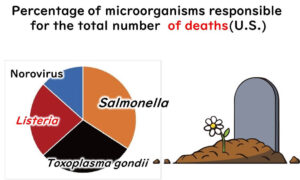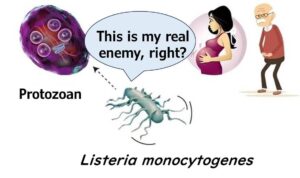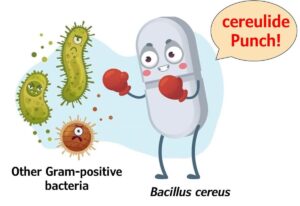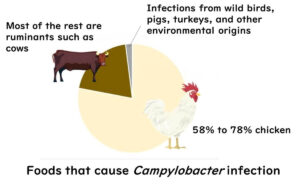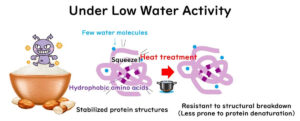Estimating the Total Number of Food Poisoning Cases (Patients, Hospitalisations, Deaths) in a Country
Estimating the total number of food poisoning cases, including the number of patients, hospitalisations, and deaths, as well as ranking the number of incidents, is not an easy task. The paper I am introducing today, authored by Dr. Scallan and his team from the U.S. Centers for Disease Control and Prevention, attempts to estimate the number of food poisoning cases in the United States caused by different pathogens. This estimation is based on statistical data, active surveillance, passive surveillance, and other sources of data.
Over Disinfection and Rough Hands: The Role of the Good Indigenous Skin Bacterium Staphylococcus epidermidis
Staphylococcus aureus, often referred to as S. aureus, is a notorious bacterium known for causing inflammation on the skin. This "bad guy" of the microbial world can lead to food poisoning and opportunistic infections. But is there a "good guy" that can combat S. aureus on our skin? For a long time, there was no clear scientific evidence. However, in 2017, Dr. Nakatsuji and colleagues from the University of California, San Diego, provided groundbreaking evidence that indeed there is a beneficial bacterium capable of eliminating S. aureus. They discovered that Staphylococcus epidermidis, a common skin bacterium, plays a crucial role in keeping S. aureus at bay.
Listeriolysin O (LLO) in Listeria monocytogenes: Defence Against Protozoa in Animal Gut and Soil?
When Listeria monocytogenes infect humans, they invade the epithelial cells of the intestines and cleverly evade immune responses, such as macrophage predation, by parasitizing inside cells. This cunning infection mechanism leads to Listeria infections, which are particularly dangerous for pregnant women, causing miscarriages, and for the elderly, resulting in severe conditions like sepsis and meningitis. A critical factor in Listeria infection is Listeriolysin O (LLO). This article introduces research by Dr. Pushkareva and colleagues from the Russian Academy of Medical Sciences, which suggests that Listeriolysin O originally evolved in the natural ecosystem as part of a predator-prey relationship with the ciliate Tetrahymena.
Did Human Pathogenic Genes of Vibrio Species Evolve in Deep-Sea Vents?
What exactly is pathogenicity when it comes to pathogenic microorganisms affecting humans? Were the genes responsible for pathogenicity specifically developed to infect humans and cause food poisoning? In this article, we’ll explore how the genes that make Vibrio parahaemolyticus and Vibrio cholerae pathogenic to humans have evolved in the natural world, completely independent of any human infection routes.
Not Made for Us: The Ecological Origins of Bacillus cereus Toxin
Research shows that the pathogenic factors of foodborne microorganisms harmful to humans have not necessarily evolved to target humans. In this article, we introduce studies on cereulide, the emetic toxin responsible for food poisoning caused by Bacillus cereus. One such study suggests that cereulide, which causes vomiting, might originally function as an ionophore antibiotic in nature, attacking other bacteria, rather than targeting humans.
Are There Other Routes of Campylobacter Infection Besides Chicken?
Campylobacter food poisoning is widely associated with chicken, especially undercooked poultry dishes. This belief is commonly held. However, Campylobacter is not limited to chickens raised on poultry farms. It can also be found in the intestines of cattle, pigs, sheep, and goats, as well as wild animals and birds. This indicates that various meats within the food supply chain could potentially serve as infection sources.
So, what proportion of Campylobacter foodborne infections can truly be attributed to chicken meat? In this article, I introduce a study that examines this question using molecular epidemiological methods.
Norovirus and Asymptomatic Carriers: A Hidden Risk in Food Handling
It’s possible for healthy, asymptomatic food handlers infected with norovirus (asymptomatic carriers) to spread the virus, making them potential infection sources. However, there’s a lack of systematic research on the viral load, excretion amount, and duration in the stool of these asymptomatic carriers and their individual variations. Let's dive into the study by Dr. Teunis and his team from the Epidemiology Research Division in the Netherlands.
The Relationship between Water Activity in Food and Microbial Heat Resistance During Heat Sterilisation
Low water activity in food increases microbial heat resistance during heat sterilization, making careful heating of these foods crucial. How much does microbial heat resistance increase as water activity decreases? This article summarizes the impact of water activity on microbial heat resistance in foods.
Unified Protocol for Environmental Monitoring in Food Manufacturing
There are no specific protocols provided by ISO standards for environmental monitoring in food manufacturing plants. However, having concrete protocols is convenient when conducting monitoring in the field. In 2012, EU experts worked on establishing a unified protocol, particularly for the important bacterium Listeria monocytogenes. This article provides a digest of this protocol, focusing on key points with illustrations for clarity. While the focus is on Listeria, the fundamental methods of microbial sampling in food factories are also covered, making this a valuable read for beginners in food microbiology.
The Importance of Environmental Monitoring in Food Factory Hygiene Management
In the context of food factory hygiene management, the Environmental Monitoring Programme (EMP) plays a critical role as a tool for microbiological testing. Numerous cases of foodborne illness and product recalls have shown that the implementation of HACCP alone is not sufficient to prevent microbiological contamination. This article outlines the fundamental principles of environmental microbiological monitoring in food manufacturing plants.
